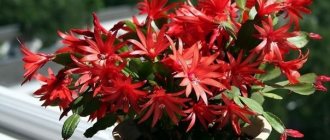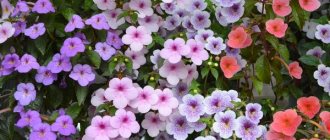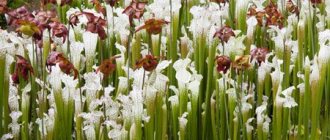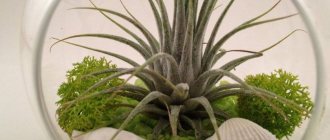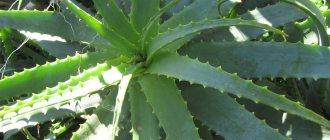Schlumbergera or zygocactus is an unpretentious indoor flower that can bloom in winter, in December, when other plants are dormant or sick from lack of sun - made it a favorite for a long time and awarded it with the popular nicknames “Decembrist”, “Christmas cactus” or “Christmas cactus”. Schlumbergera is a branching plant with long articulated branches (another popular name for the flower is “cancer neck”). What we usually mistake for Decembrist leaves - thin plates fastened to each other - is actually the stem of the flower, on which its buds appear.
The article describes the main indoor species of Schlumbergera, gives advice on how to make Decembrist bloom, and also provides basic recommendations for propagating and caring for this plant.
Kinds
This unusual flower came to us from the tropical rainforests of Brazil. It is worth noting that Schlumbergera is a cactus that has only adapted to dampness and heavy rains. He survived in such conditions due to the fact that he became an epiphyte - that is, he learned to live on other plants. At the same time, the flower is not a parasite - it does not “eat” its owner, but simply coexists peacefully with him.
Schlumbergera truncatus
In this species, shoots can reach 40 cm in length, the stems hang beautifully. The color of the stem is light green, sometimes with a reddish tint; the size of one fragment of the stem varies from 4-5 cm in length and up to 2-2.5 cm in width. There are sharp teeth on the sides of the segments. The flowers of this variety have a variety of shades: from white and pink to purple and lilac.
Schlumberger truncated
Schlumbergera bucklei
It is also an ampelous type of plant; its stem segments have rounded teeth. Flowers appear at the ends of the stems. The color of the flowers is pinkish-lilac.
Schlumberger Buckley
The difference between Schlumbergera truncated and Hedgehog
Schlumbergera opuntioides
This species is more reminiscent of a cactus - the stem segments are teardrop-shaped and covered with spines growing in numerous areoles. In addition, the stem fragments are much thicker than those of other Zygocactus species. This species blooms with pinkish-purple flowers in March-April.
Schlumbergera prickly pear
Schlumbergera gaertneri
The stem segments of this species can reach a length of 6-7 cm. The flowers are orange-red, with pointed petals.
Schlumberger Gertner
Schlumbergera Russelliana
The stems of this species can reach 1 meter in length. The stems are bright green, with red veins, shiny, fleshy. The leaves are round in shape. Blooms red-violet and pink flowers.
Schlumberger Rousselian
Origin of the plant and distribution area
It may seem strange to many that Schlumbergera came to us from the tropics. Can cacti really live in hot and humid forests? Yes they can. And the rainy tropics did not stop them. The fact is that cacti settle at an altitude of 600-1500 m above sea level. They are compact bushes, peeking out cutely from cracks in the bark or from under huge vines. Cacti grow into the trunk of the vine and feed on decaying organic matter.
A beautiful plant, the flowering of which does not obey any laws of nature, came to us from the tropical forests located in the southeast of Brazil
When segments break off, roots grow on them very quickly and new plants quickly attach to the support and continue to live and develop. Since cacti are located high above the ground, frequent tropical rains only moisten them and the drops flow down. Therefore, Schlumbergers live in prolonged dry conditions.
Schlumbergera blooms with completely unusual, red-orange flowers with bright stamens that stand out beautifully above the elongated petals.
Under natural growing conditions, plants bloom in late spring or early summer. And here Schlumbergera blooms in winter, since our winter corresponds in time to the Brazilian summer. The plant has excellent genetic memory, so it is not affected by changes in geographic latitude. As determined by genetics, the plant begins to bloom.
Schlumbergera or ripsalidopsis?
The Schlumbergens have real confusion with their relatives. Decembrist belongs to the subfamily of epiphytic cacti. In addition to Schlumbergera, this subfamily includes three more species of cacti:
- Rhipsalis;
- Lepismium;
- Hatiora (ripsalidopsis) (read more about Hatiora).
Previously, Schlumbergera was compared to Ripsalidopsis, and now you can still find the division of flowers into Schlumbergera and Ripsalidopsis.
But according to the modern classification of plants, rhipsalidopsis is included in the species hatiora. Therefore, looking for differences between Schlumbergera and Ripsalidopsis is not entirely correct. It would be more correct to say that Schlumbergera is similar to Hatiora, but plants of one species can still be distinguished from plants of another by a number of characteristics:
- Schlumbegera and hatiora flowers have different flowering and dormant times. The real Decembrist blooms in December-January, and hatiora (ripsalidopsis), on the contrary, blooms in the spring. That is why this species was nicknamed “Easter cactus” or “Easter cactus”. Hatiora's dormant period occurs in autumn and winter, before flowering.
- Decembrist's flowers resemble a regular star, while Easter's flowers are asymmetrical, slightly curly, and you can see a tube in them.
- The shape of the stem plates of Schlumbergera is oblong with denticles. Hatiora has smooth serrations; sometimes the edge of the plate may have a reddish color.
Yes, the two types of plants have differences, but they are still very similar, and the principles of caring for them are the same.
Care
Zygocacti are not too picky. They grow well on a windowsill in an ordinary apartment. However, if you want to have a healthy, flowering plant, then it is better to adhere to the basic rules of caring for them.
Soil and replanting
In nature, zygocacti, like other epiphytes, can grow in tree crevices, holding onto the bark with their roots. Therefore, their root system is not very developed, and the pot can be taken not too large, and drainage should occupy about a third of it.
Plants are replanted depending on the growth and filling of the pot before growth begins - in March-April. For a young, fast-growing plant, annual replanting is possible; for an adult flower, replanting can be done once every 3-4 years.
You can take ready-made soil for Schlumbergera from the store. Soil for cacti is suitable, but it needs to be diluted by a quarter with coarse sand. You can prepare the soil yourself. To do this you need to take:
- Leaf humus;
- Peat in small quantities;
- Sand or perlite so that the soil is loose and allows water to pass through;
- Don't forget about the drainage layer.
Fertilizer
Fertilizing should be carried out from March to September 1-2 times a month with fertilizers for cacti and succulents, and only on moist soil. You can’t fertilize in winter!
Temperature, watering and lighting
Spring - Summer: this is a period of active growth, the temperature should be about 20-25 degrees. It is better to place zygocacti in places with good diffused light, avoiding direct sunlight, which burns the leaves. South-east and south-west windows are best suited for cactus. It is not recommended to place the plant in the shade. Feels great on balconies and loggias - in well-ventilated areas. Watering is moderate as the soil dries completely. About once a week. You can look at the condition of the leaves; if they become softer, a little flaccid, you need to water the plant.
- For zygocactus, it is better to water from the bottom;
- Decembrists love high humidity. You can spray them from time to time;
- In the summer, you can bathe the zygocactus in the shower;
- For irrigation, use clean water (settled or filtered) at room temperature.
Autumn - Winter: Preparing the plant for flowering:
Caring for Schlumbergera at home. Details
Schlumbergera flowers rarely appear indoors. To increase the likelihood of flowering, you need to know the details of plant care.
Bloom
It is no coincidence that the Schlumbergera plant received the name Decembrist.
Its flowering occurs just in December. Some species bloom in February. Buds begin to appear in early December . At this time, you cannot disturb the plant - turn it, move it to other rooms. Such actions can lead to the buds falling off.
Also at this time it is necessary to maintain humidity and feed the flower. The room temperature during flowering should be about 20℃.
If the described conditions are provided, you can see bright flowers of different shades. The most common colors are red, white, pink, purple, orange.
Temperature
In winter, the room temperature should not be higher than 20℃. If the temperature is elevated, the plant will not wither, but the buds from which flowers develop may not appear. Another important condition for kidney development is short daylight hours.
Also, temperatures should not be too low. At a temperature of 3-5℃ the plant will die. In summer, the plant will be comfortable at a temperature of 15-20℃.
But the heat should not be constant, otherwise the Decembrist will not bloom at home.
Spraying
To ensure flowering, Schlumbergera must maintain high air humidity.
Spraying should be plentiful and constant, especially in summer. In winter, spraying must be done with caution to prevent frostbite of the flower. The water with which it will be sprayed must be warm. Lack of moisture will cause the buds to drop.
Lighting
A good solution for the location of the Decembrist would be to place it on the windowsills of the eastern and western sides. In these places it will have enough sun, and the likelihood of drying out will be significantly reduced.
to place the Schlumberger over radiators and heaters .
Watering
As for this point on caring for indoor Schlumbergera, the peculiarities of the plant’s origin are taken into account.
In summer and during flowering, regular and abundant watering is required .
The rest of the time it can be reduced to 1 time per week.
Pot
The root system of the plant is poorly developed, because under environmental conditions the flower begins its development near the roots of trees. This means that initially it does not require a large pot. A pot 10 cm high and 6 cm in diameter will be enough.
Priming
Based on the previous point, we can conclude that the Decembrist requires the most loose soil possible. You can prepare it yourself. This will require 1 part peat, 1 part sand and 1 part deciduous or turf soil.
You can make drainage at the bottom of the pot. It must conduct moisture well, because Schlumbergera does not like stagnant water.
Under no circumstances should Decembrist be planted in clay or loam. This soil does not conduct moisture well and limits air access. Other deviations from the described conditions are acceptable, but it must be taken into account that Schlumbergera may not bloom.
Feeding and fertilizer
The flower can also grow in poor soils. But to ensure its beautiful appearance, feeding is required. The plant should be fed no more than 2-3 times a year during flowering and growth.
When purchasing fertilizers, you should pay attention to the composition. If there is nitrogen in the composition, its content should be average. Excess of this substance will lead to rotting of the roots.
Schlumbergera transplant
It is best to transplant while the plant is growing.
When choosing a pot, you need to take into account the need to grow the root system in breadth, not in depth. Therefore, the new pot should be the same depth. The width of the new pot should exceed the width of the previous one by 2-3 cm.
The soil needs good drainage because the roots are more susceptible to rot when replanted.
Young plants are replanted every year, older plants - once every 2 years.
How to trim Schlumbergera
There is an important point regarding pruning Schlumbergera - it is not advisable to cut the plant. It is better to pluck the heavily overgrown parts. Plucking is important because it causes new shoots to appear and new buds to develop from them.
Rest period
This period begins immediately after the plant blooms. During the dormant period, your home Schlumbergera should be kept in a cool place. The desired temperature is 15℃. Decembrist rarely needs to be watered and sprayed. The main thing is to ensure that the soil does not dry out.
Is it possible to leave the plant without care during the holidays?
If you are planning a family vacation, it is advisable to have someone water the plant while the owners are away. It is especially dangerous to leave Schlumbergera without watering in the summer.
Bloom
In the autumn period (from late September to mid-November), for the formation of flower buds , the zygocactus needs to change the conditions:
- Place in a cool place where the temperature will not be higher than 20˚, but not lower than 10-13˚;
- Reduce watering;
- The place in which the Schlumbergera will be located must be shaded.
In mid-late November, move the Decembrist to a warm place, place it on the windowsill.
- During the period when buds or flowers appear on the Decembrist, it is important not to turn its other side towards the sun and not to move it at all, since the Decembrist can drop them without starting to bloom;
- The flowering plant is watered, but not sprayed;
- Fertilizers are not needed during flowering.
To stimulate the growth of buds in March-April, long shoots are pinched. To do this, you need to break off or unscrew 1-2 segments of an old, long shoot.
What colors are Christmas trees?
There are a lot of varieties, their differences relate to the color and shape of the petals . The stem segments differ in size and, in some rare cases, color.
- Schlumberger with a white flower looks very attractive:
- White Christmas;
- Angel Dance;
- White Bell;
- Aspen;
- Madame Butterfly.
Bridgeport;
White Decembrist is a light-loving plant, but direct sunlight can cause burns on the flower stems. The segments of white Decembrists are dark green in color. In the center of the shoot there is a pronounced vein.
Reference! When temperatures are too low, the pure white petals of hybrid varieties take on a pink tint.
The group of white varieties and hybrids includes plants with a cream color.
White flowers are characteristic of Aspen and White Christmas varieties, and yellow flowers are characteristic of Golden Cream. The Santa Cruz variety, artificially bred, has an orange color. For the Decembrists, yellow is not a typical color. But the breeders' many years of work were not in vain. The following varieties have been developed:
- Christmas flame;
- Cambridge;
- Twilight Tangerine.
They differ from other zygocacti in the shades of their flowers: from pale yellow to rich gold. The length of the bud can reach 9 cm.
Reproduction
Cuttings
The easiest method of propagation is cuttings. For propagation, it is necessary to break off or unscrew a small shoot from an adult plant - 2-3 segments are enough. The cuttings need to be dried for several days and then buried at a slight slope in prepared moist soil. Rooting will occur better if you cover the cutting with a glass jar. But in this case, regularly ventilate and remove condensation so that your cutting does not rot.
Using seeds
Schlumbergera may bear fruit. But in indoor conditions it is quite difficult to obtain the fruit, because the flowers need to be pollinated. In nature, this is done by hummingbirds or hawk moths. But if you have different types of Decembrist that you wouldn’t mind crossing, try our method.
- It is better to carry out pollination on the 2-3rd day of flowering;
- Pick a flower from one plant and pollinate the flower of another with it, immersing the pistil in pollen;
- If the plants do not bloom at the same time, then the flower of one zygocactus can be preserved - within a couple of weeks it will not lose its properties;
- The fruit that will set as a result of these manipulations - a small berry - should ripen within 6-8 months;
- The berry should become soft to the touch, after which it is picked and the seeds are cleaned in a weak solution of manganese.
However, if waiting for the fruits of the Decembrist is too long and tedious, then you can buy seeds of different varieties of Schlumbergera in the store and, planting them on one windowsill, enjoy a mix of flowers of different colors in the winter.
- It is better to sow zygocactus seeds in May-June, on moist soil;
- There is no need to cover them with soil;
- You can cover with film and ventilate regularly, removing excess moisture from time to time;
- You can pick young plants 2 months after the seeds germinate;
- Read more about how to grow succulents from seeds.
Plant grafting
Decembrist can also be grafted onto other plants, for example, prickly pear, echinopsis or pereskia. The grafted plant will bloom abundantly and retain the characteristics of its variety in full.
- To graft, a cut is made on the supply and then split;
- 2-3 segments of the zygocactus are broken off, and then the break is carefully sharpened;
- Insert the segments into the cleft of the supply and fix them with a thin needle or a narrow strip of fabric;
- The temperature should not be higher than 18-20˚;
- Decembrist can grow onto another plant in a couple of weeks;
- After growth, you can remove the supporting needles and bandages;
- It is also necessary to remove growing shoots in a timely manner so as not to break the graft.
Diseases and pests
Schlumbergera is not particularly demanding in care, but it can also get sick if you do not follow the rules of watering and lighting.
- The shoots are sluggish and pale. Perhaps the zygocactus is experiencing a lack of light and watering;
- The shoots began to turn red. This happens if the Schlumbergera is in direct sunlight;
- Decembrist does not bloom. This means that the rest period was not properly organized: coolness, shading and poor watering;
- If the zygocactus has dropped its buds and flowers, then most likely the plant has changed the direction of illumination, the temperature has changed, or the flower is standing in a draft;
- Erosion (with redness) appeared on the leaves - the plant was burned.
- Most often, the plant suffers from fungal or bacterial diseases. Rotten and diseased parts of the plant are carefully removed. Treatment is carried out with fungicides.
- Among the pests that can settle on a flower are mealybugs, spider mites, and scale insects. Special products from the store can handle them perfectly.
Possible difficulties or how to avoid mistakes?
When growing Schlumbergera, many gardeners encounter some problems.
Schlumbergera Orchidaceae
Let's look at the most common mistakes in care, which can lead to rotting of the root system, weakening and withering of leaf segments and their redness:
- The segments acquire an unpleasant reddish tint. There is nothing wrong with the leaves turning red - no. This means that you kept the plants at an uncomfortable temperature for a long time. The acquisition of a reddish tint by the leaf segments indicates hypothermia, and this is its protective reaction. After the plant sits in a warm room, the leaves will turn green again.
- What causes wrinkled and limp leaves? This problem depends on 5 mistakes that flower growers make. Wrinkling and lethargy of foliage can be affected by: watering with cold water, prolonged drying of the earthen ball, excessive bathing in the sun, prolonged decrease in temperature, application of fertilizers in high concentrations. If lethargy is affected by waterlogging, it is most likely that the root system begins to rot. You need to immediately remove the plant from the pot, dry the lump and replant it in new soil. If the roots begin to rot, it is necessary to revive Schlumbergera - cuttings and propagation.
- How to prevent buds from falling off? The plant does not like changing location. To avoid stressful situations that result in buds falling off, it is not recommended to frequently move the flower pot to a new location.
- Lack of flowering . This problem can be associated with many factors: lack of sufficient natural light or, conversely, excessive, improper watering, lack of a period of rest and keeping in a cool room. The plant may grow in an improperly sized pot or in poorly nutritious soil.
- What is the reason for the fact that a plant loses its leaves? If leaf fall begins, it means that a spider mite has settled on the plant. The appearance of the pest is facilitated by increased dry air, lack of hygiene procedures, infrequent watering with prolonged drying of the earthen clod, and lack of regular fertilizing. To correct the situation, you need to treat the plant against spider mites and then follow agricultural practices for caring for Schlumbergera.
To avoid mistakes in care, you should know that the plant does not tolerate drafts. When fertilizing, Schlumbergera responds well to complex fertilizers, but they need to be applied only at half the concentration, otherwise this will lead to yellowing, wilting and falling of the foliage, and poor flowering with pale flowers.
